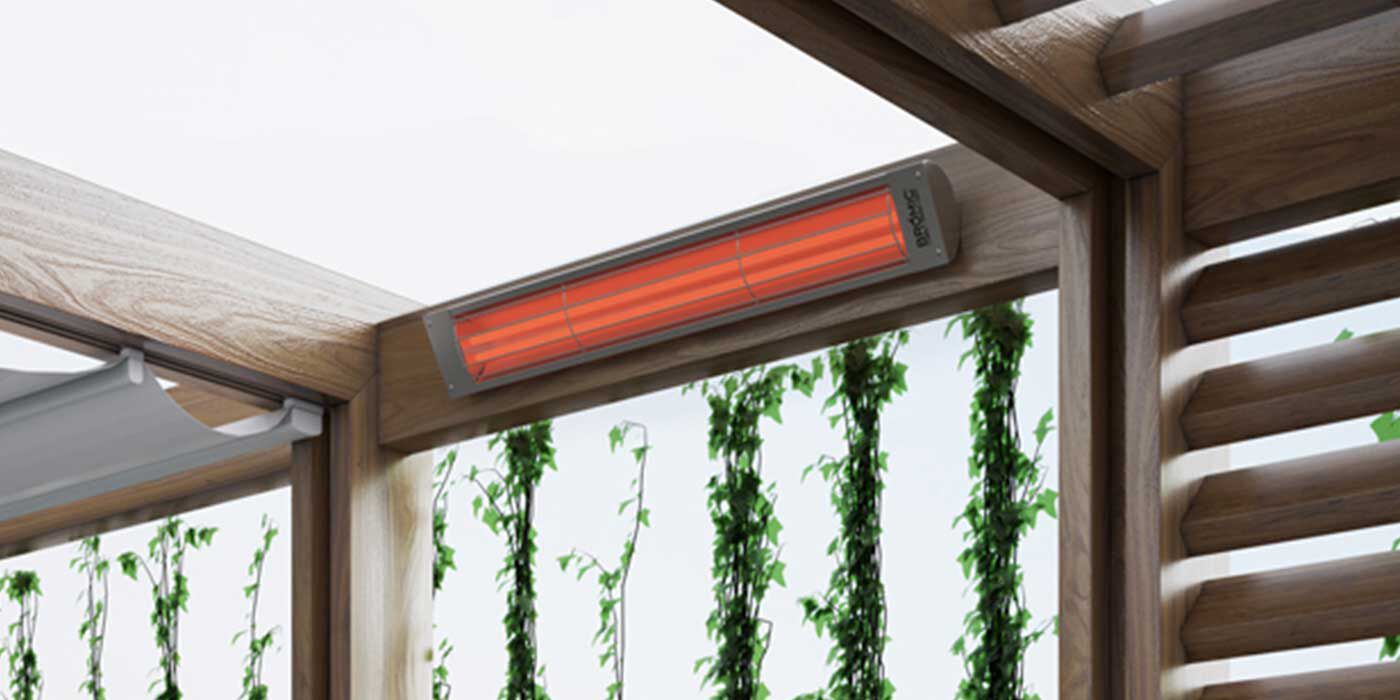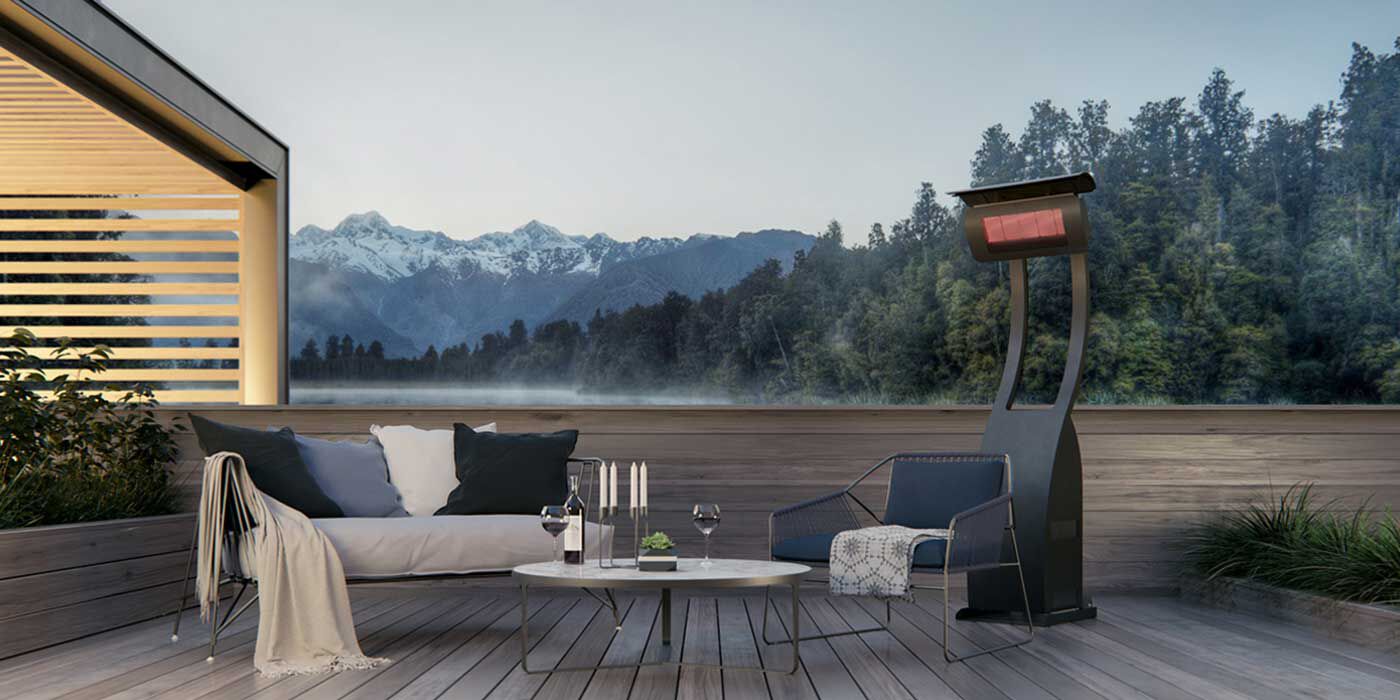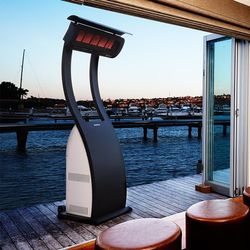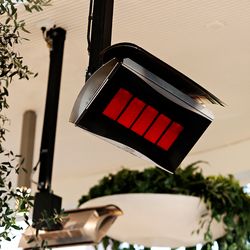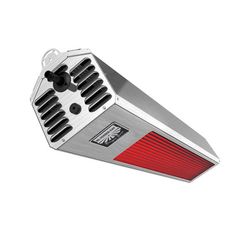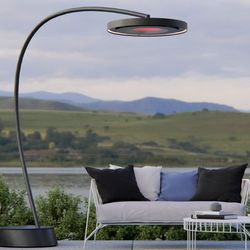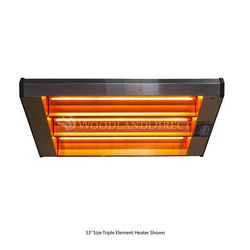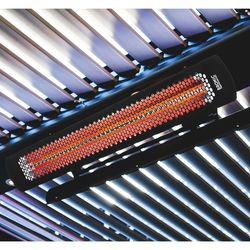By: Nick Janco, NFI Certified Master Hearth Professional
Last Updated: October 15, 2025
Patio heaters are ideal for homeowners who want to extend the life of their backyard retreats and businesses looking to offer outdoor seating year-round.
In addition to finding the right kind of patio heater for your outdoor living space, it’s important to make sure your heater is placed in a safe spot to boost its performance and prevent potential fire hazards.
Use the following tips to properly place your patio heater, so you can enjoy countless cozy nights lounging in your outdoor sanctuary, no matter the season.
Where Can You Install Your Patio Heater?
The installation location for outdoor heaters varies, depending on the type of fuel you use and the style of heater you select.
Patio heaters are available in portable, freestanding styles, and ground, wall, or ceiling-mounted models.
Portable heaters only require a propane tank and can be moved around to suit your heating needs, while mounted heaters will require a permanent gas line or hard-wired electricity, which can limit installation.
Best locations for mounted or recessed heaters:
- Exterior wall of a house facing the patio/deck
- Awnings/overhangs above a patio/deck
- Screened-in porches
- Gazebos
- Pergolas
- Mounted into the ground of a patio
- Enclosed restaurant patios
- Open-air restaurant patios
- Indoor/outdoor rooms
Best locations for portable heaters:
- Patios
- Decks (if pre-approved by manufacturer)
- Open-air spaces with solid ground
- Garages
Size Up Your Space
The size of your outdoor space will determine the best patio heaters, how many you'll need, and where you can put them.
If you squeeze a heater that’s too large into a compact space or if you install a small patio heater in a big, open area, you won’t get the best possible performance from your new unit.
Wall-mounted models are great solutions for small spaces, while freestanding and ground-mounted heaters tend to throw heat over a longer distance, making them ideal for large backyards or commercial venues.
You can also install multiple heaters throughout your space to get the heating coverage you need. Electric patio heaters, for example, can be grouped together into heating zones to heat specific areas at any given time.
To determine how much heat you need:
- Measure the length and width of your outdoor space to find the square footage.
- Use the following equation to determine how many BTUs you'll need to heat your space: Cubic feet of area x desired temperature rise = BTUs needed.
Once you know the measurements of your space and the BTUs required to heat it, you’ll be able to find a patio heater in the proper style and dimensions to fit your requirements.
Check Your Surroundings
Patio heaters are not intended to radiate intense heat over great distances. Rather, they’re designed to comfortably warm nearby people and objects.
Placing your patio heater too close to certain materials creates a dangerous fire hazard. You'll need to consult the installation manual that comes with your patio heater to make sure you've met any specific clearance requirements.
Be sure to keep your heater at least three feet away from combustible materials, such as potted or hanging plants, outdoor decorations and furniture, and propane tanks used for grilling or fueling another fire feature in your yard.
When choosing the final location for your heater, focus on areas where people will gather, but be sure to avoid walkways and other high-traffic zones.
Luckily, most patio heaters are equipped with safety features, like an anti-tilt shut-off valve that turns off the heater if it gets knocked over or tips past a certain angle.
The safest patio heaters are UL and CSA-approved, which means they've undergone rigorous testing to make sure they're reliable.
Just like fire pits, gas patio heaters are strictly for outdoor use, it’s possible to put one in a semi-enclosed space, such as a covered patio, if the ceiling height is at least 10 feet tall.
If your space is covered, you’ll need to make sure it's ventilated and has sufficient airflow.
In addition to measuring the exact height of your covered patio, you’ll also need to consult the installation manual that comes with your heater to confirm that your space meets the clearance requirements.
Patio Heaters in Enclosed Spaces
Electric patio heaters are the safest and most environmentally friendly option because they don't require ventilation, can be used indoors and outdoors, and don't produce carbon emissions.
Electric infrared patio heaters come in both freestanding and wall-mounted models and are the simplest option to set up. You can also recess electric heaters into flat ceilings for a clean, seamless look.
Best Surfaces for Your Patio Heater Placement
Freestanding patio heaters should always be placed on a solid, stable surface, especially if you live in a windy area.
Uneven ground, like grass or gravel, creates instability and may cause your heater to perform poorly or tip over, resulting in a potential fire.
If your patio heater requires a natural gas line, you'll need to have a licensed professional install one for you. The location of the gas line may affect where you can place your heater.
How to Choose Your Final Location
Once you've found the right kind of patio heater for your outdoor space, you're ready to pick your final location:
- Carefully read through the installation manual, so you can make sure you've taken all the necessary precautions, and your location of choice meets clearance requirements.
- If you have a portable or freestanding patio heater, place it in an area where your guests will likely gather, making sure to avoid walkways and other high-traffic areas.
- Keep your heater at least three feet away from combustible materials, and always place portable heaters on a solid, stable surface to avoid accidents and potential fires.
- For permanent installations, make sure the location can accommodate a hard-piped gas line for gas patio heaters or hardwired electricity for electric patio heaters.
- Gas patio heaters can be installed in semi-enclosed spaces, such as covered patios, as long as there is sufficient ventilation, air circulation, and the ceiling is at least 10 feet tall.
- Electric patio heaters are the safest option and come in a variety of mounted models designed for indoor and outdoor use.
- You can group electric heaters into heating zones to warm specific areas in your space and recess them into your ceiling for a seamless finish.
Our Most Popular Gas Patio Heaters
Our Most Popular Electric Patio Heaters
Prefer to Listen?
FAQs
There are several types of outdoor heaters — propane heaters, natural gas, and electric models. Each fuel type offers unique advantages. For example, propane units are portable and powerful while electric heaters are great for small areas and offer easy upkeep.
Most models heat up quickly — usually within seconds for infrared heaters and a few minutes for gas.
Portable models are typically DIY-friendly, especially propane units that just need a tank connection. However, for built-in natural gas or hardwired electric systems, it’s best to hire a licensed electrician or gas technician to ensure a safe and proper installation.
Yes, infrared heaters are often more efficient outdoors because they transfer heat directly to people and objects. Traditional space heaters lose much of their warmth to open air, while infrared models perform better in breezy environments.
We're Here to Help
Have more questions about patio heaters? We’d love to help! Call our team of NFI certified experts today at 800.919.1904.
More Resources
If you’re still stuck on choosing the best heater for your patio, browse our Patio Heater Buying Guide to help make your decision!
Gas and electric patio heaters both have their benefits, but which type is right for you? Discover the pros and cons of each kind.
Learn how adding patio heaters can significantly boost your business year-round.
 |
Nick Janco is a seasoned Technical Sales Representative with a decade of experience at Woodland Direct. As an NFI-Certified Master Hearth Professional, Nick is dedicated to helping his clients seamlessly integrate fire features into their homes, ensuring every detail is perfectly executed. While he's trained to assist with any fire-related project, Nick specializes in patio heaters. He's helped thousands of satisfied clients find the best heating solutions, offering valuable design, safety, and installation advice. Outside of work, Nick often spends time on the green enjoying a round of golf with his 5-year-old son. Call Nick or one of our experts in fire at 800.919.1904. |


